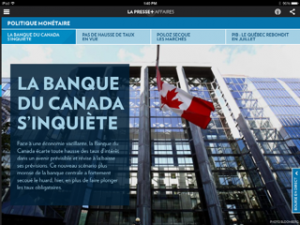Could La Presse’s tablet app fill the gap in the logic behind giving away news for free?
One reason I’m not a fan of paywalls for news sites is that, with a few exceptions, the case for them seems to come down to: If they don’t work, we’re doomed, ergo they will work.
I may have shown up for only four out of every five sessions of my 7 a.m. college Logic class, but even I can spot a flaw in that argument.
On the other hand, most of the arguments for keeping news sites free seem to harbor a sort of desperately hopeful, even Panglossian view: If we pile up a big enough audience, eventually we’ll figure out a way to find enough advertisers to pay for access to them. Not, perhaps, much more solid ground than the paywall people. But my attitude in general is that failing at an endeavor is not shameful, but failing in the same way twice is downright stupid. The model of asking people to pay for news has led to smaller and smaller audiences. Even pre-Internet, my rough calculations suggest, the percentage of Americans willing to pay for newspapers was declining steadily for decades.
Still, it’s been uncomfortable putting my belief on an economic model for free news sites that reminds me of the famous S. Harris cartoon in which, in the middle of a dense equation that fills up an entire wall of chalkboard, there is the notation “Then a miracle occurs.” For free news sites, the miracle is that advertisers, who have been spreading their dollars increasingly thinly across an ever-growing array of possible outlets, somehow for some reason decide to divert a larger share to one category.
The caption to Harris’s cartoon has one scientist telling the other, “I think you should be more explicit here in step two.” Guy Crevier, publisher of La Presse in Montreal, got a little more explicit recently about why advertisers might flock back. This is from an interview with Steve Faguy (and Faguy’s whole story is well worth your time). Crevier talks about the $40 million La Presse put into developing a free app.
“We could have launched a paid La Presse app,” Crevier said. “We might have gotten 30,000 subscribers, people who are very happy, very satisfied.”
But the real money isn’t in paid subscriptions, it’s in advertising. “What do I do with 30,000 subscribers?”
“Say it’s been three years that we’ve done this and we’ve reached 150,000 subscribers, and then Radio-Canada releases a free app and reaches 600,000 or 700,000 subscribers?”
So far, not any different from the basic argument for free: Traditional newspapers have relied on having a large audience; paywalls or paid apps turn them into niche products for an elite. But ad rates for mass audiences online are a fraction of their old print equivalents. How does Crevier expect to make the app pay?
By charging print rates, plain and simple.
Faguy notes that many of the La Presse app’s early advertisers are getting special deals, and the company isn’t public so it only discloses the numbers it wants to. So we can’t tell now whether La Presse can pull this off. But the logic Crevier uses is at least a smidgen more explicit than in some other cases. For one thing, La Presse is working with advertisers to develop ads that take full advantage of a tablet app’s capabilities, in the hope that doing so will make the ads more effective. Second, Crevier suggests that the closed system of an app allows for better monitoring of reader interaction with ads, which can not only give advertisers more data about their potential customers but also lead to refinements making the ads more and more effective. Third, apps can offer advertisers a more engaged audience than the web:
For Crevier, the iPad is different. It’s more like a newspaper that people flip through than a website that people click on. And data show that people spend 35 minutes flipping (or swiping) through the app on average during weekdays, and 70 minutes on weekends. The hope is that because of that, the ads will be able to draw more newspaper-like rates.
Finally, Crevier believes that tablet apps, more so even than the web itself, offer a revolutionary new medium:
“Our profound understanding is that the tablet will become its own media, stronger than television, stronger than newspapers, stronger than magazines. Because it’s interactive, it’s mobile, it has exceptional reproduction, it has sound, video.”
There’s more, much more, at Faguy’s blog. The screen grabs of the La Presse app show something that goes far beyond basic apps that provide little more than a feed off a website flowing into a rigid format.
I subscribe to the Telegraph’s app (because I’m an Anglophile, and because I like its puzzles). I appreciate some of the qualities it shares with La Presse’s app, especially the sense of completeness: I can flip through a fixed number of stories and reach an end, unlike the essentially endless content on its website. There is a satisfaction, a sense of accomplishment when I come to the end of each day’s content. But the Telegraph app doesn’t provide any links to live content (La Presse does, but admits the packaging could be better) and its content pages don’t take much advantage of the tablet’s capabilities.
The current La Presse app isn’t the ultimate in design or interface. And as Faguy notes, we don’t have any clues to its financial success. But Crevier has erased “Then a miracle occurs” and replaced it with some actual logic.

